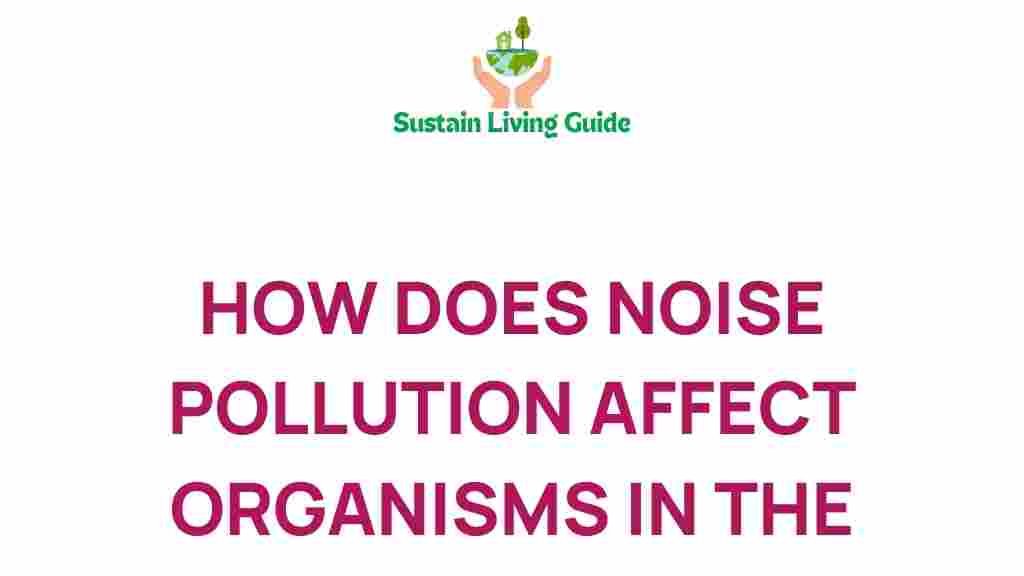The Hidden Impact of Noise Pollution on Ecosystems
Noise pollution is often overlooked in discussions about environmental degradation, yet it has profound effects on ecosystems that can disrupt the delicate balance of nature. While many people are aware of the detrimental impacts of air and water pollution, the consequences of excessive noise are frequently underestimated. This article aims to explore the hidden impact of noise pollution on ecosystems, examining how it affects wildlife, plant life, and overall biodiversity.
Understanding Noise Pollution
Noise pollution refers to the harmful or annoying levels of noise in the environment, typically produced by urban development, transportation systems, industrial activities, and even recreational activities. Common sources include:
- Traffic noise from vehicles
- Airplane noise from airports
- Industrial machinery sounds
- Construction activities
- Urban nightlife and loud music
This constant barrage of sound can interfere with the natural behaviors of various species and can lead to serious ecological consequences.
The Effects of Noise Pollution on Wildlife
Wildlife is particularly sensitive to noise pollution. Here are some of the major impacts:
1. Altered Communication
Many animal species rely on sound for communication, mating calls, and navigation. Noise pollution can mask these important auditory signals, leading to:
- Difficulty in finding mates
- Increased stress levels due to communication breakdown
- Disruption of social structures within species
2. Habitat Displacement
Continuous noise can drive wildlife away from their natural habitats. Animals may abandon areas that are noisy, which can lead to:
- Fragmentation of populations
- Increased competition for resources in quieter areas
- Potential extinction of species unable to adapt
3. Impacts on Reproductive Success
Studies have shown that noise pollution can impact the reproductive success of birds and other species. This can occur through:
- Increased stress hormones affecting fertility
- Inhibition of natural breeding behaviors
Effects on Plant Life
While the focus is often on animals, plants are also affected by noise pollution. The effects include:
1. Reduced Pollination
Many pollinators, such as bees and butterflies, are sensitive to noise. Disruption in their natural foraging and mating behaviors can lead to:
- Decreased pollination rates
- Reduced crop yields and biodiversity
2. Stress Responses
Plants can also respond to noise pollution. For instance, exposure to high-decibel sounds can trigger stress responses, affecting growth patterns and resilience against diseases.
Biodiversity Loss and Ecosystem Balance
The cumulative effects of noise pollution on wildlife and plant life can lead to significant biodiversity loss. This alteration of ecosystems can disrupt food webs and ecological interactions, resulting in:
- Declining populations of key species
- Altered nutrient cycling
- Reduced ecosystem services, such as pollination and water purification
Step-by-Step Process: Mitigating Noise Pollution
Addressing noise pollution requires a multi-faceted approach. Here’s a step-by-step process to mitigate its impacts:
Step 1: Awareness and Education
Educate communities about the impacts of noise pollution on ecosystems. Workshops, seminars, and informational campaigns can help raise awareness.
Step 2: Policy Implementation
Advocate for policies that regulate noise levels in urban planning and development. This may include:
- Establishing noise barriers
- Implementing zoning laws
- Encouraging quieter machinery in industries
Step 3: Community Involvement
Encourage community projects aimed at reducing noise pollution. This can include:
- Planting trees and vegetation to act as sound buffers
- Creating community guidelines for noise levels
Step 4: Monitoring and Research
Support ongoing research to monitor noise pollution levels and its effects on ecosystems. This data can help inform future policies and conservation efforts.
Troubleshooting Tips for Noise Pollution Issues
For individuals looking to reduce noise pollution in their immediate surroundings, consider the following tips:
- Soundproofing: Use soundproofing materials in your home to reduce noise from outside.
- Landscaping: Plant trees or shrubs around your property to act as natural sound barriers.
- Community Action: Work with neighbors to establish quiet hours and reduce noise from parties or loud music.
Conclusion
Noise pollution is a hidden threat that significantly impacts ecosystems, wildlife, and plant life. By understanding its effects and taking proactive steps, we can mitigate its impact and protect our natural environments. As individuals, communities, and policymakers, we have the responsibility to address this issue and foster a healthier planet.
For more information on environmental issues, visit this resource. To learn more about reducing noise pollution in urban areas, check out this guide.
This article is in the category Eco-friendly and created by SustainLivingGuide Team
